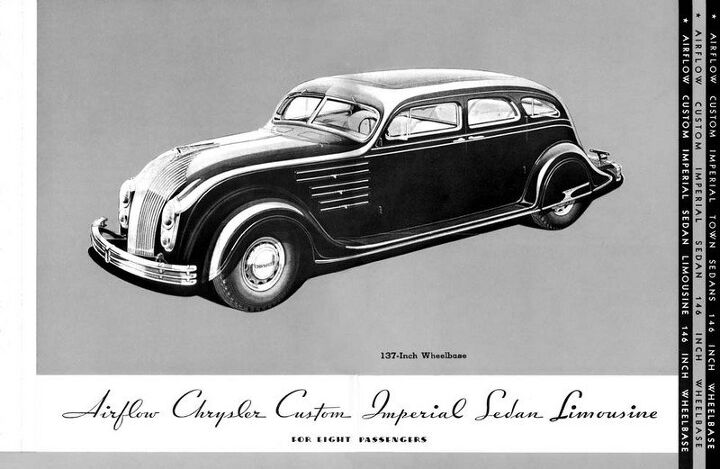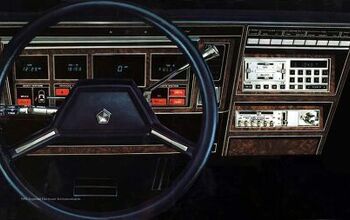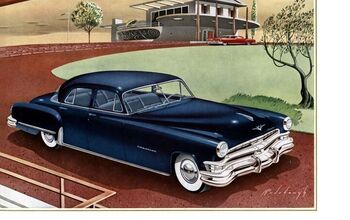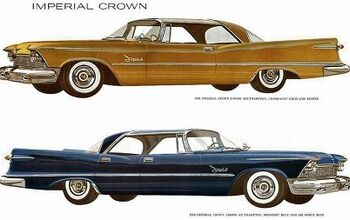Rare Rides Icons: The History of Imperial, More Than Just a Car (Part II)

Rare Rides Icons continues the history of Imperial today, after Part I left us neatly at what would become an unfortunate aerodynamic turning point. Ready for some Airflow?
Imperial’s big sweeping fenders lead into wide running boards while driving lamps presented themselves on stalks in front of superbly upright and formal chrome grille work. Bodies were of the coachbuilt variety, and wore badges by LeBaron and Dietrich, among others. But it was a new era of aerodynamic design at Chrysler, and all of those legacy looks had to go.
The basis for what became the third-generation Imperial of 1934 was Chrysler’s Airflow. Chrysler had big, bold aspirations with its new car, and proudly proclaimed the Airflow as the first full-size domestic production car that used streamlining as a basis of design. Smooth shapes punched much cleaner holes in the air and meant less resistance. That meant better performance, much quieter operation, and an entirely new profile for the full-size automobile.
The Airflow project was in its design phase in the late Twenties, as Chrysler engineers conducted wind tunnel testing with the assistance of one Mister Orville Wright. The end goal was to discover the best, most natural forms for wind resistance that could still be applied to a passenger car (since it couldn’t just be an airplane fuselage). Today a designer would breathlessly call it an organic design methodology but such terms were not lexicon then.
By April of 1930 more than 50 tests had been conducted with scale model shapes. What Chrysler found was the en vogue formal two-box shape was generally more aerodynamic if it were driven backward. Alongside the education about streamlining, engineers considered new construction methods. A separate chassis with a coachbuilt body on top was heavy and inefficient, even if it was what the public was used to (and desired).
“But what about a unibody?” said Chrysler. Less weight and more rigidity meant a better car, so they set to it.
The unibody construction and the aerodynamic body were breakthroughs never before seen in the automotive world. The Airflow and its counterparts wore full steel bodies with steel structures underneath, foregoing the traditional involvement of dead trees. Chrysler was very pleased with its design, which also lent itself to much safer weight distribution. Two-box cars had too much weight over the rear wheels with their heavy bodies and engines aft of the front wheels – a problem that was exacerbated when they were fully loaded. With around 75 percent of the weight at the rear, very stiff leaf springs were necessary which made for a harsher ride. In less than ideal traction conditions, it also meant dangerous oversteer when the back tires broke free and then swung the car around like a pendulum.
Airflow addressed this problem by moving its engine forward, over the front wheels. That meant the passenger compartment was moved forward too, so weight was concentrated in the middle, and nobody was sitting over the rear axle. As a result, the cab-forward Airflow had around 54 percent of its weight over the front wheels, which made for a near 50:50 weight distribution when loaded with people. No harsh rear springs were required, which made for much better ride quality and handling.
The breakthrough aerodynamic “Imperial Airflow Series” was introduced in 1934, with a new slogan, “The car of tomorrow is here today.” Gone were the past coachbuilding offerings, as Imperial’s factory shapes were limited to a two-door coupe, four-door sedan, or longer four-door limousine. When it debuted there were three different wheelbases on offer: CV at 128 inches, CX at 137.5 inches, and the longest CW of 146 inches. CV models used a 324 cubic inch (5.3L) Chrysler inline-eight, which for the first time was the exact same engine used in its Chrysler counterpart. CV cars were more affordable than their Imperial predecessors and started at $1,625, or just under $34,000 adjusted. The mid-length CX was limited to four-door body styles called Sedan, Limousine, or Town Limousine.
CX was a decent jump in price to $2,345 ($48,700 adj) and left plenty of room for the cream of the crop Series CW. The 146-inch wheelbase CW came with length and pricing, its full name the Imperial Custom Airflow Series CW, as the Custom name returned to denote a top trim. Like CX, CW was available as Sedan, Limousine, or Town Limousine, but it used the largest 385 cubic-inch (6.3L) inline-eight. That engine was an entire liter larger than the largest available on the Chrysler Airflow. For all its grandiose nature, the CW asked an even $5,000, or $103,900 adjusted. Transmissions on baser Imperials were a three-speed manual, while longer wheelbase customers received a four-speed manual with overdrive.
In the early Thirties, the Imperial was in the (more conservative) super luxury class alongside the Rolls-Royce Phantom III, Cadillac Series 90, Packard Twelve, and the Mercedes-Benz 770. In its first year, Chrysler shifted 2,277 CV cars, 106 mid-level CX, and 67 top-tier Custom CWs. Given those figures, a problem was immediately apparent to Chrysler: The vast majority of consumers hated how the Airflow design looked, in any guise. They were put off by its radical shapes, big sweeping grille, and lack of a trunk. The year after the Airflow, Chrysler released a new version of the more common Six model called the Airstream. While it was basically a heavy refresh, the Airstream wore more conventional Chrysler looks. Chrysler hoped it could sell Airstream along with the halo Airflow models and drum up additional sales.
But they didn’t have to drum up anything, as Airstream immediately outsold the Airflow. Airstream was more traditional and thus more appealing, and cost much less than the Chrysler Airflow, much less the haughty Imperial. Airstream outsold the Airflow five to one in its debut year, and nine to one in ’36. Meanwhile, the Imperial series was renamed C-2, C-3, and CW for 1935, and was largely a continuation of the prior year using leftover materials made for the 1934 model year.
Actual changes for 1935 included a slight resizing of the CX (C-2), which shrunk its wheelbase from 137.5 inches to 137. The CW picked up that length however and grew from 146 to 146.5 inches. The already limited sales from Imperial’s debut year remained stable in 1935, with 2,598 C-2s, 125 C-3s, and 32 CWs. Airflow’s end was near.
1936 was the final year for the Airflow Imperial, as it bowed out a year earlier than its Chrysler sibling. New for its curtain call was a distinctive mesh grille, a revised (no longer smooth) rear that allowed a luggage compartment for storage aside from the spare tire, and a roof completely made of steel. The final cars were renamed again, to Series C-10, C-11, and CW. The C-10 managed 4,500 sales in ’36, but the C-11 fell to 75 examples, while the CW sold only 11. From its debut year, base pricing dropped about 20 percent on the C-10 and 5 percent on the C-11.
Chrysler took a risk with its third edition Imperial, and by and large, the public responded with “Or not.” The following year, Chrysler retorted with a fourth Imperial that returned to form and was bound to bring its traditional customer base back into the fold. Until next time.
[Images: Chrysler]

Interested in lots of cars and their various historical contexts. Started writing articles for TTAC in late 2016, when my first posts were QOTDs. From there I started a few new series like Rare Rides, Buy/Drive/Burn, Abandoned History, and most recently Rare Rides Icons. Operating from a home base in Cincinnati, Ohio, a relative auto journalist dead zone. Many of my articles are prompted by something I'll see on social media that sparks my interest and causes me to research. Finding articles and information from the early days of the internet and beyond that covers the little details lost to time: trim packages, color and wheel choices, interior fabrics. Beyond those, I'm fascinated by automotive industry experiments, both failures and successes. Lately I've taken an interest in AI, and generating "what if" type images for car models long dead. Reincarnating a modern Toyota Paseo, Lincoln Mark IX, or Isuzu Trooper through a text prompt is fun. Fun to post them on Twitter too, and watch people overreact. To that end, the social media I use most is Twitter, @CoreyLewis86. I also contribute pieces for Forbes Wheels and Forbes Home.
More by Corey Lewis
Latest Car Reviews
Read moreLatest Product Reviews
Read moreRecent Comments
- Rover Sig 2021 Jeep Grand Cherokee Limited, like my previous JGC's cheap to keep (essentially just oil, tires) until recent episode of clunking in front suspension at 50K miles led to $3000 of parts replaced over fives visits to two Jeep dealers which finally bought a quiet front end. Most expensive repair on any vehicle I've owned in the last 56 years.
- Bob Hey Tassos, have you seen it with top down. It's a permanent roll bar so if it flips no problem. It's the only car with one permanently there. So shoots down your issue. I had a 1998 for 10 years it was perfect, but yes slow. Hardly ever see any of them anymore.
- 3-On-The-Tree 2007 Toyota Sienna bedsides new plugs, flat tire on I-10 in van Horn Tx on the way to Fort Huachuca.2021 Tundra Crewmax no issues2021 Rav 4 no issues2010 Corolla I put in a alternator in Mar1985 Toyota Land Cruiser FJ60 280,000mi I put in a new radiator back in 08 before I deployed, did a valve job, new fuel and oil pump. Leaky rear main seal, transmission, transfer case. Rebuild carb twice, had a recall on the gas tank surprisingly in 2010 at 25 years later.2014 Ford F159 Ecoboost 3.5L by 80,000mi went through both turbos, driver side leaking, passenger side completely replaced. Rear min seal leak once at 50,000 second at 80,000. And last was a timing chain cover leak.2009 C6 Corvette LS3 Base, I put in a new radiator in 2021.
- ChristianWimmer 2018 Mercedes A250 AMG Line (W177) - no issues or unscheduled dealer visits. Regular maintenance at the dealer once a year costs between 400,- Euros (standard service) to 1200,- Euros (major service, new spark plugs, brake pads + TÜV). Had one recall where they had to fix an A/C hose which might become loose. Great car and fun to drive and very economical but also fast. Recently gave it an “Italian tune up” on the Autobahn.
- Bd2 Lexus is just a higher trim package Toyota. ^^









































Comments
Join the conversation
A really innovative car for its time. Very good article. Thanks Corey for another interesting well written story.
I've just recently watched Sunset Boulevard and wonder if an article about the Isotta Frischini would fit in a similar article group.